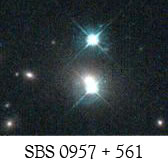
History of Gravitational Lensing

Gravitational Lensing Way Back When (1700s-Newton Era)
During the 1700s, Newton first questioned how distinct bodies affect rays of light, but this was a truly rhetorical question. The idea was somewhat forgotten until later on, with Einstein. A few scientists tried to determine the properties of light when affected by gravity. For example, in 1784, John Mitchell concluded that light would be redshifted because of gravity. This means that the light would be increased in wavelength, lower in frequency, and less energetic. Henry Cavendish (1784) and Von Soldner (1804) made calculations for the deflection of light, but these were set aside because the deflection of .84 arcseconds seemed too small of a difference to be seriously considered.
Early Interest and Work (1912-mid 1900s)
In 1912, Einstein also questioned the effect that gravitational masses have on light. His theory of relativity postulated that mass changes space-time curvature, so therefore light from distant objects should bend around massive objects. Einstein was somewhat sure of his hypothesis, but never thought it was possible to view such a phenomenon from earth. Because of this, he left the topic entirely until many years later. Even though Einstein was not working on gravitational lensing, other scientists were making progress in his absence. In 1919, Frank Dyson proposed the idea of using the solar eclipse with the Hyades star cluster to test Einstein’s theory. Two teams of scientists went to observe the phenomenon and confirmed full deflection.
Later, in1936, a Czech engineer persuaded Einstein to publish his findings on gravitational lensing in Science magazine. Einstein’s article confirmed what others had been discovering. Another scientist, Frits Zwicky backed Einstein’s findings in the Science magazine but said that it was easier to observe distant galaxies through gravitational lensing than stars. Scientist Russell also believed in gravitational lensing and made up a hypothetical situation in which it would work. For example, on a hypothetical planet, during an eclipse between a white dwarf and the star Sirius, the inhabitants would be able to see the deflected light of Sirius. Unfortunately, scientists on Earth would not be able to view such a phenomenon. Our problem was that astronomical masses ideal for gravitational lensing seemed hard to find.
See more regarding Newton vs Einstein and gravitational lensing
Renewed Interest (1960s-present)

The early 1960sbrought us the discovery of quasars. Quasars are distant, and very luminous, objects that have a high redshift as well. Thisdiscovery gave a viable option to be used for gravitational lensing, with a less distant galaxy acting as the gravitational mass that deflects the quasar’s light. In 1979, Dennis Walsh, Robert F. Carswell, and Ray J. Weymannso found two quasars very close together (6 arcseconds) and were identical. This being very unlikely, they had the firstglimpse of gravitational lensing in action. The two images are actually just double projections of one distant quasar. 1988 brought us the first possible glimpse of an Einstein ring, MG1131+0456.
Works Cited
Tilman Sauer, " A brief history of gravitational lensing " in: Einstein Online Vol. 4 (2010), 1005
Cain, Fraser, and Jeff Barbour. "Near Perfect “Einstein Ring” Discovered." Universe Today — Space and Astronomy News. Universe Today, 29 Apr. 2005. Web. 19 Aug. 2011. <http://www.universetoday.com/10480/near-perfect-einstein
ring-discovered/>.
Brainerd, Jerome J. "The Astrophysics Spectator: Simulator of a Point-Source Gravitational Lens." The Astrophysics Spectator: Home Page. 2 Nov. 2009. Web. 19 Aug. 2011. <http://www.astrophysicsspectator.com/topics/generalrelativity/GravitationalLensPointSim.html>.